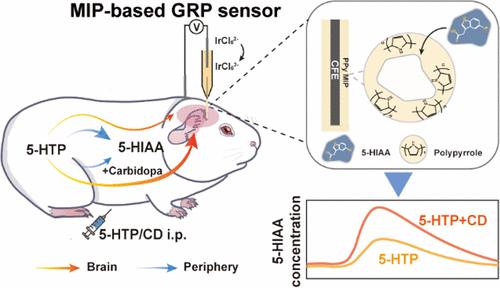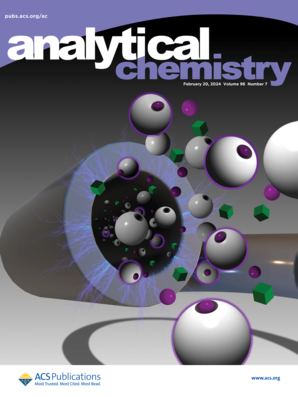利用基于分子印迹聚合物的电化学氧化还原电位传感器实时监测豚鼠大脑中的 5-羟基吲哚乙酸
IF 6.7
1区 化学
Q1 CHEMISTRY, ANALYTICAL
引用次数: 0
摘要
本文章由计算机程序翻译,如有差异,请以英文原文为准。

Real-Time 5-Hydroxyindoleacetic Acid Monitoring in Guinea Pig Brain Using a Molecular Imprinted Polymer-Based Galvanic Redox Potentiometric Sensor
5-Hydroxyindoleacetic acid (5-HIAA), a vital metabolite of serotonin (5-HT), is crucial for understanding metabolic pathways and is implicated in various mental disorders. In situ monitoring of 5-HIAA is challenging due to the lack of affinity ligands and issues with electrochemical fouling. We present an advanced sensing approach that integrates customizable molecular imprinting polymer (MIP) with self-driven galvanic redox potentiometry (GRP) for precise, real-time in vivo monitoring of 5-HIAA. The sensor, featuring pyrrole as the functional monomer in the MIP on the micrometer-sized bipolar carbon fiber electrodes, exhibited nanomolar sensitivity and superior selectivity for 5-HIAA over biosynthetic pathway analogs like 5-hydroxytryptophan (5-HTP) and serotonin. The MIPGRP sensor demonstrated excellent reversibility and resistance to fouling, enabling continuous monitoring in live guinea pig brains. We observed that intraperitoneal 5-HTP injection increases brain 5-HIAA levels, which is amplified up to 8-fold with Carbidopa pretreatment, providing deeper insights into the serotonergic signaling pathway. This work underscores the MIPGRP sensor’s potential as a versatile and reliable tool for advancing neuroscience research.
求助全文
通过发布文献求助,成功后即可免费获取论文全文。
去求助
来源期刊

Analytical Chemistry
化学-分析化学
CiteScore
12.10
自引率
12.20%
发文量
1949
审稿时长
1.4 months
期刊介绍:
Analytical Chemistry, a peer-reviewed research journal, focuses on disseminating new and original knowledge across all branches of analytical chemistry. Fundamental articles may explore general principles of chemical measurement science and need not directly address existing or potential analytical methodology. They can be entirely theoretical or report experimental results. Contributions may cover various phases of analytical operations, including sampling, bioanalysis, electrochemistry, mass spectrometry, microscale and nanoscale systems, environmental analysis, separations, spectroscopy, chemical reactions and selectivity, instrumentation, imaging, surface analysis, and data processing. Papers discussing known analytical methods should present a significant, original application of the method, a notable improvement, or results on an important analyte.
 求助内容:
求助内容: 应助结果提醒方式:
应助结果提醒方式:


